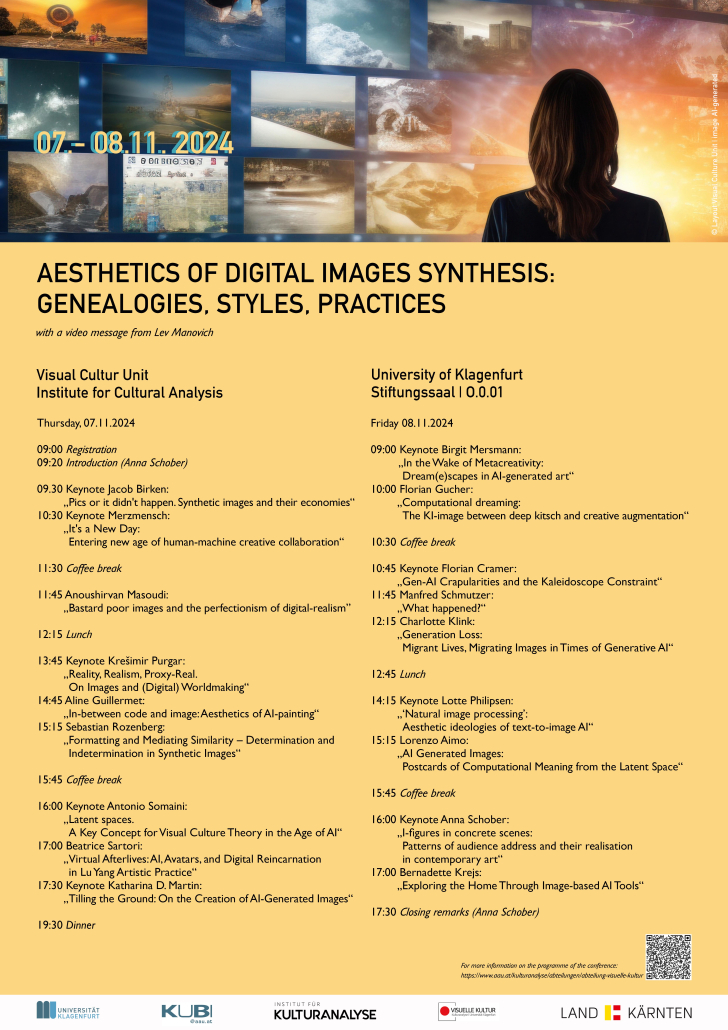Ⓒ 2024 University Klagenfurt, Visual Cultures
Katharina D. Martin
Tilling the Ground:
On the Creation of AI-Generated Images.
This paper explains the creative process of digital image production as a human/non-human interaction that resembles soil cultivation. One hypothesis is that digital technology has established itself as ground in the Kantian sense, as the earthly foundation on which we stand and from which we develop all our knowledge and skills. So, what is the nature of this ground, what is its surface like? Does it resemble a paved road with a fixed infrastructure or the cultivated soil from which something grows? Tim Ingold’s concept of the anti-stratigraphic cultivation of surfaces gives a good starting point here. (Ingold 2022: 184-6) When writing with ink, something is deposited in the depths of the surface. This inscription cannot be wiped off, it penetrates the surface and changes the material. However, the ground may permit the inscription but produces almost nothing itself. When working in the field, on the other hand, the surface of the soil is broken open in order to deposit seeds so that something may grow. The ground is cultivated, it becomes a productive surface and resembles an interface with at least two access points. It should not be forgotten, that with the process of depositing and harvesting, the soil is permanently changed.
My assumption is that interfaces for digital image production are more than a paved surface with permanently installed infrastructures, but rather resemble a ‘deep surface’. (Spuybroek 2016: 58) The digital programmes have to be cultivated, so that something new may emerge. And yes, here too the ground itself is changed through production. This is also where the users’ agency and responsibility lie. The assumption of a technical, political, and social inevitability is only a myth, because there are of course actors. (Weizenbaum 1976: 241) To elicit growth from the image and text generating programmes, you have to till the ground. It will be necessary to engage in new forms of inscribing in the sense of soil cultivation. One example is writing prompts. Here we should bear in mind that the requests are deposits that change the ground from which one tries to derive new forms. Therefore the ‘prosumers’, which are caught in the middle of the creative production, should avoid monoculture, as this stands in the way of future, not yet actualised, diversity.
Katharina D. Martin (Dr. phil.) is Visiting Fellow at Erasmus University Rotterdam. She was Associated Member at the Cluster of Excellence Image Knowledge Gestaltung at Humboldt University Berlin and taught image theory at ArtEZ University of the Arts Arnhem. Relevant publications: Technik als Problem des Ausdrucks. Über die naturphilosophischen Implikationen technikphilosophischer Theorien (transcript 2023), 'Ein Streifzug durch die Abstraktionsebenen digitaler Formen' (Trópos 15/1, 2023). mail@kdmartin.eu | https://www.eur.nl/esphil/people/katharina-dany-martin
International Conference * Aesthetics of Digital Images Syntheses: Genealogies, Styles, Practices * 07.-08. November 2024 * University Klagenfurt * Institut for Cultural Analysis unit Visual Culture
The conference relates the research fileds of visual studies, art history, art science and aesthetics to artificial intelligence. Current approaches to image science and artistic research in these fields will be examined in relation to current phenomena of digital image generation by AI in popular visual culture and art. In addition to the production and the aesthetic manifestation, the reception and the situations in which images created in this way are used will also be discussed. -Registration for the conference: Sabine.Pfeiffer@aau.at
